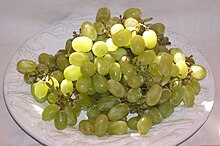Table grape
Table grapes are grapes , i.e. fruits of the grapevine , which, unlike wine grapes, are not used for winemaking but are eaten raw as fruit . Table grapes do not ripen after harvest, they are non-climatic fruits .
Requirements and regulations
The requirements for table grapes are different from those for wine grapes: the grapes should have loose berries, the berries should be large, juicy, with little or no seeds and have a delicate skin. In addition, early maturity is desirable.
With the reform of the EU wine market regulation on August 1, 2000, wine law no longer applies to table grapes . They can therefore be grown like other fruits such as apples, pears or cherries. If this happens outside of vineyards and without planting rights , the legal regulations must be observed: No varieties that are classified as wine varieties (e.g. Regent or Phoenix ) may be planted .
White varieties

- Angela
- Aron
- Birstal nutmeg
- Guarantor
- Gutedel , Vroege van der Laan
- Italia
- Queen of the Vineyards
- Lignan Blanc , yellow silk grape
- Lilla
- Muscat d'Alexandrie
- Nelly
- New York , Lakemont seedless
- Palatina
- Pearl from Csaba
- Perlona
- Pölöskei Nutmeg
- Prime
- Primus
- Regina
- Romulus
- Sultana , Thompson Seedless
- Suzi
- Theresa
- Vanessa
- Verdelet
- Victoria
Red and blue varieties

-
Black Hamburg
This is the trade name for the table grape of the red grape variety Großvernatsch (Italian: Chiavo grosso ). - Boskoops Glory
- Canadice
- Cardinal
- Clarissa
- Crimson Seedless
- Emperor
- Flame Seedless
- Gallant
- Ganita
- Royal Esther
- Michurinsky
- Muscat Bleu
- Muscat de Hamburg
- Nero
- Osella
- Red Globe
- Red Suffolk
- Swenson Red
Table grape varieties and their characteristics frequently grown around the world
The world production of table grapes in 2014 was around 27 million tons. Around half of world production came from three countries: the People's Republic of China, India and Turkey.
| country | 2000 | 2014 |
|---|---|---|
|
|
1.3 | 9.2 |
|
|
0.9 | 2.1 |
|
|
2.1 | 2.1 |
|
|
1.0 | 1.4 |
|
|
0.9 | 1.2 |
|
|
1.5 | 1.1 |
|
|
1.4 | 1.0 |
|
|
0.4 | 1.1 |
|
|
0.4 | 0.8 |
| World as a whole | 15.7 | 27.0 |
| variety | Characteristics | countries |
|---|---|---|
| Alphonse Lavallée | very large, dark, seed-containing grapes with a firm skin | Argentina, Chile, Turkey, Peru |
| Crimson Seedless | small to medium-sized, red, elliptical, seedless berries | Egypt, Italy, Peru, South Africa, United States |
| Dattier de Beyrouth | large, white, pitted berries, densely packed, with thick skin and firm flesh | Italy, Spain, Turkey |
| Flame Seedless | medium-sized, seedless, red berries | Argentina, Chile, Egypt, Peru, South America, United States |
|
Muscat de Hambourg ( Muscat Hamburg ) |
medium-sized to large dark, stone-rich berries, muscat aromas | People's Republic of China, France, Italy, Argentina, Chile, Turkey, Peru |
| Italia | very large, pithy berries in close packing | Argentina, People's Republic of China, Italy |
|
Muscat d'Alexandrie ( Muscat of Alexandria ) |
very large white, elliptical, seed-containing grapes, tightly packed, with firm flesh, intense muscatel aromas | Algeria, Argentina, Greece, Morocco, South Africa, Spain |
| Red Globe | medium-sized, red, round, pitted berries | Argentina, Australia, Chile Egypt, Italy, Peru, South Africa, United States |
| Sugraone | medium to large white, seedless berries, densely packed | Argentina, Australia, Egypt, Italy, Peru, South Africa, United States |
|
Sultana ( Sultanina ) |
small, white, seedless berries, densely packed, with a thin skin and firm flesh | Argentina, Australia, Chile, People's Republic of China, Greece, India, Iran, South Africa, Egypt, Turkey, United States |
| Victoria | large, white, elliptical, pitted berries, firm pulp | Argentina, Italy |
literature
- Volker Jörger, Rainer Engel: Table grapes also offer a chance for domestic cultivation . In: The Baden winegrower . March 2003, p. 37–42 ( online [PDF; 246 kB ]).
Web links
- Table grapes (lexicon entry)
- Bavarian State Institute for Viticulture and Horticulture : Information about table grape culture
- Bavarian State Institute for Viticulture and Horticulture: Vine in the house and in the garden (PDF, 900 kB)
- "Nero, Aron, Esther and Co" - mushroom-resistant food grapes (PDF, 300 kB)
Individual evidence
- ↑ Regulation (EC) No. 2789/99 (PDF) of the Commission of December 22, 1999 to set the marketing standard for table grapes.
- ↑ The red grape variety Großvernatsch is a variant of the Vernatsch grape, the German grape variant of which is known as Trollinger .
- ↑ a b c Food and Agriculture Organization of the United Nations and International Organization for Vine and Wine (Ed.): TABLE AND DRIED GRAPES, FAO-OIV FOCUS 2016: Non-alcoholic products of the vitivinicultural sector intended for human consumption . 2016, ISBN 978-92-5109708-3 (English, fao.org ).
